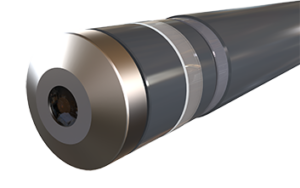Residual Ozone Monitoring and Control
Ozone has been used as a disinfectant for decades and its popularity rises and falls with changing technologies, costs and requirements. Once heralded as the new super disinfectant set to rival chlorine, ozone in water as a disinfectant is a small part of the market and is generally restricted to specialist applications. 
 Over the years, there have been many varieties of sensor from colorimetric analyzers (adding a reagent so the water sample changes color based on the amount of DO3 present, and then measuring the color change) to open electrochemical sensors. Industry has largely settled on using membraned amperometric sensors as they give the best balance between speed of response, longevity, capital and maintenance costs, stability, and sensitivity. These sensors are extremely sensitive (0.001ppm) but can suffer from pressure fluctuations in the sample and bubbles of DO3 coming out of solution. In addition they need to utilize ozone resistant materials of construction as ozone is particularly corrosive. Once a system has been set up such that:
Over the years, there have been many varieties of sensor from colorimetric analyzers (adding a reagent so the water sample changes color based on the amount of DO3 present, and then measuring the color change) to open electrochemical sensors. Industry has largely settled on using membraned amperometric sensors as they give the best balance between speed of response, longevity, capital and maintenance costs, stability, and sensitivity. These sensors are extremely sensitive (0.001ppm) but can suffer from pressure fluctuations in the sample and bubbles of DO3 coming out of solution. In addition they need to utilize ozone resistant materials of construction as ozone is particularly corrosive. Once a system has been set up such that:

What is so great about ozone as a disinfectant?
- It’s very efficient – ozone is approximately 20 times more efficient than chlorine1.
- It can tackle chlorine resistant pathogens such as Cryptosporidia Parvum and Giardia Lambia – Crypto and Giardia typically spread as oocysts which are resistant to chlorine disinfection2.
- It is much better at oxidizing organics than chlorine – disinfection by-products such as Trihalomethanes (THMs) formed by the reaction of chlorine with organics are believed to be carcinogenic. Ozone can break down the organics such that they cannot form disinfection by-products (DBPs) when chlorine is added later in the process<sup3.
- With ozone disinfection there are no disinfection by-products – ozone oxidation doesn’t result in any DBPs4.
What are the problems associated with ozone as a disinfectant?
- Very aggressive on materials – ozone is not chemically compatible with many common building materials and care must be taken over materials of construction5.
- Difficult to get into solution – particularly at high temps – ozone is notoriously difficult to get into solution and sophisticated regimes and mixing systems are required to ensure stability6.
- An extreme irritant and possibly toxic – ozone can be identified by its distinctive smell and exposure to ozone is regulated in most jurisdictions7,8.
- Capital maintenance and power intensive – ozone is generated at point of use, generally by electrical discharge through air or oxygen. The cost of such generators far exceeds the costs of a tank and a pump (chlorine).
- Difficult to measure residual and control – see below.
Applications
As mentioned above, ozone tends not to be the first choice as a disinfectant due to the cost and complexity. There are, however, specific applications when ozone is the most effective overall for the outcomes desired. The most common specific applications are described below:- Drinking water treatment – pre-treatment (organics) – dissolved ozone is used to destroy the organics from a raw water source in order to reduce the scope for disinfection by-products to form when chlorine is added later in the process.
- Water treatment – pre-treatment (Fe and Mn removal) – ozone can be extremely effective at oxidizing both iron and manganese to insoluble forms which allows their removal from drinking water prior to additional treatment9.
- Bottled drinking water – bottled drinking water is often disinfected with ozone because it is extremely effective and leaves no residual. In turn this means that there is no residual taste. Once treated with ozone the bottles are sealed and the water requires no residual disinfectant.
- Aquaculture/Aquaria – ozone is used in aquaria and aquaculture to disinfect the water and reduce the residuals required10 (please read on for further comments on the ozonation of seawater).
- Washing (decay prevention) – low levels of ozone can reduce the bacteria on the surface of foodstuffs (particularly fruit), which can greatly prolong the onset of decay, extending its shelf-life and therefore increasing its value.
- Some industrial wastewaters – some industrial wastewaters require an extremely powerful oxidizer to make the waste safe for the environment.
- Pools and spas – in the 80s and 90s, there was a drive to reduce chlorine in pools and spas and ozone was introduced. Over time, the cost of purchasing and monitoring ozone dosing equipment in pools has tended redirect this emphasis towards better monitoring and control of chlorine dosing.
Measuring and controlling ozone disinfection
Getting ozone to stay in solution long enough to achieve a residual that can be measured consistently, and therefore control the process, is a challenge. Very often the amount of Dissolved Ozone (DO3) in a solution has less to do with the ozone demand or the amount dosed and more to do with the ambient conditions that can cause ozone to come out of solution. That, and the relatively small residuals required, provide a challenge for the monitoring and control of DO3. Monitoring small residuals requires an extremely sensitive and stable ozone sensor. Over the years, there have been many varieties of sensor from colorimetric analyzers (adding a reagent so the water sample changes color based on the amount of DO3 present, and then measuring the color change) to open electrochemical sensors. Industry has largely settled on using membraned amperometric sensors as they give the best balance between speed of response, longevity, capital and maintenance costs, stability, and sensitivity. These sensors are extremely sensitive (0.001ppm) but can suffer from pressure fluctuations in the sample and bubbles of DO3 coming out of solution. In addition they need to utilize ozone resistant materials of construction as ozone is particularly corrosive. Once a system has been set up such that:
Over the years, there have been many varieties of sensor from colorimetric analyzers (adding a reagent so the water sample changes color based on the amount of DO3 present, and then measuring the color change) to open electrochemical sensors. Industry has largely settled on using membraned amperometric sensors as they give the best balance between speed of response, longevity, capital and maintenance costs, stability, and sensitivity. These sensors are extremely sensitive (0.001ppm) but can suffer from pressure fluctuations in the sample and bubbles of DO3 coming out of solution. In addition they need to utilize ozone resistant materials of construction as ozone is particularly corrosive. Once a system has been set up such that:- there is good disinfection of dosed O3
- the monitoring position is set sufficiently downstream of the dosing point to ensure a steady state but not so far downstream that the DO3 could have come out of solution
The ozonation of seawater
Adding ozone to seawater brings an extra level of complexity in that ozone oxidizes the bromide ions in seawater to HOBr. This oxidation reaction reduces the DO3 to OH radicals which in turn also act as an oxidizing disinfectant. Effectively, adding O3 to seawater can mean that disinfection is achieved by both DO3 and HOBr. There can also be a residual free bromine. This set of reactions makes it extremely difficult to control dosing using a DO3 sensor, and many operators simply use a Free Bromine (or Total Bromine) sensor to control their addition rates.References
- World Health Organization. Water Treatment and Pathogen Control: Process Efficiency in Achieving Safe Drinking Water (2004)
- Korich, D. et al, Effects of Ozone, Chlorine Dioxide, Chlorine and Monochloramine on Cryptosporidium parvum Oocyst Viability. Applied and Environmental Microbiology 56, 1423-1428 (1990)
- Montecalvo, J., Williams, D. Application of Ozonation on Sanitizing Vegetable Process Washwaters. California Polytechnic State University, San Luis Obispo (2006)
- United States Environmental Protection Agency. Wastewater Technology Fact Sheet: Ozone Disinfection (1999)
- United States Nuclear Regulatory Commission. Material Compatibility with Ozone. (2018)
- United States Department of Environmental Protection, Department of Water Supply and Wastewater Management. Drinking Water Operator Certification Training, Chapter 27: Ozone
- Jule, Y., Michaudel, C., Fauconnier, L., Togbe, D. & Riffel, B. Ozone-induced acute and chronic alterations in the lung in mice: a combined digital imaging and functional analysis. European Respiratory Journal. 52, 4313 (2018)
- Health and Safety Executive. Ozone: Health Hazards and Control Measures (2014)
- H. Paillard, B. Legube, M.M. Bourbigot & E. Lefebvre. Iron and Manganese Removal with Ozonation in the Presence of Humic Substances. Ozone: Science & Engineering 11 93-113 (1989)
- Centre for Environment, Fisheries and Aquaculture. Ozone – potential application in depuration systems in the UK (2010)
Need Help?
Need a Price?
Not in United States?
Share









